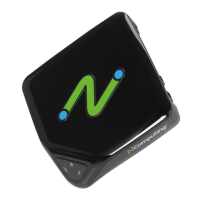|
5
NComputing L300 Virtual Desktop
Evaluation Guide
Selective Virtualization at the Server
No specialized hardware is needed to achieve a high fidelity experience; server CPU utilization is minimized by only
virtualizing those things needed for the virtual desktop experience. NComputing calls this a multi-layer virtualization
technique. Whereas many solutions virtualize everything on the OS, the vSpace software selectively virtualizes only
the necessary elements of the OS and hardware and combines that with session management to provide user and
session virtualization while minimizing CPU resource utilization.
NComputing will virtualize components like audio, graphics, video, input devices, and file system access points.
This technique allows for greater user density without virtualizing system resources that are of no use to the user.
Additionally, the NComputing multi-media subsystem can dynamically detect when multimedia is being used,
compress it for transport to the access device and accelerate it for a high-fidelity experience.
This solution is hardware agnostic and does CODEC independent media acceleration. As long as the host server can
play the media it can be played at the client. Most desktop virtualization solutions either limit the number of CODECs
supported on the server or require that a specific CODEC be supported at the client for client-side rendering.
Clients Utilize NComputing’s Own NUMO System-on-Chip
The NComputing client utilizes a dual-core ARM CPU with embedded media processors that support dynamic
bandwidth management and multiple protocols and codecs like UXP and H.264. The system on a chip (SoC) is
intended to be a hybrid of a general purpose computing platform and multi-media player. General purpose clients
typically lack local multi-media capabilities, which, in turn, requires more software to do the same thing than can
done with the L300. As a result, traditional thin clients use much more CPU power.
The NComputing solution includes the smallest, necessary multimedia elements at the client to ensure high fidelity
multimedia with the least amount of CPU. For traditional thin clients to accomplish the same requires a CPU, GPU,
Local Storage, USB Hub and Ethernet controller which can be done with a single, inexpensive SoC. In short, the
Numo SoC requires a fraction of the memory, storage and power of a traditional thin client, thus driving down
costs at the client.
Purpose-Built Protocol
The NComputing UXP protocol was purpose built with a strong end-user experience in mind for desktop virtualization.
Many virtualization solutions were purpose built for server administration, 1:1 desktop virtualization or centralized
computing (e.g. PC Blades). As a result, many of these protocols offer decent experiences, but are expensive and
have significant resource overhead to make up for any deficiencies.
NComputing utilizes a single protocol to optimize the user experience plus cost / benefits to the business such as
better network utilization. Most protocols need to either be integrated with a 3rd party solution at the client side
or server side with API add-ons to achieve what NComputing does in a single protocol. 3rd party integration with
API add-ons increases the numbers of processes running between the server and client and consumes more CPU
resources, thus driving up cost.
NComputing can also integrate the UXP protocol with our multi-layer virtualization and multimedia subsystems
ensuring minimum resource utilization on the host to improve the user experience. No other vendor owns server,
client, and protocol like NComputing. This requires other vendors to integrate multiple software components from
numerous companies, which, in turn, carry their own overhead and costs in to the system. For those vendors, there is
no opportunity to optimize the end-to-end experience and minimize resource utilization because many elements are
out of their control.

